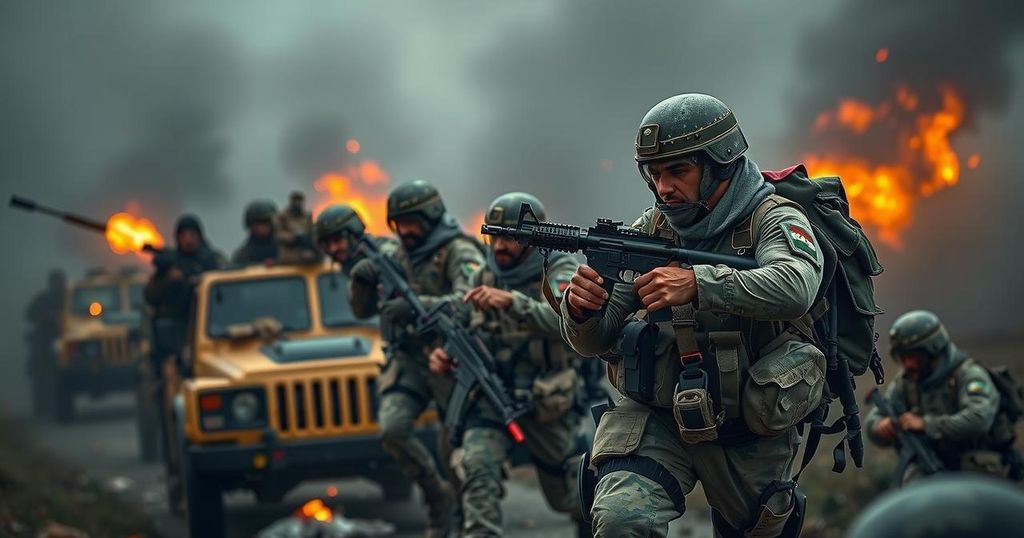World news
ALEPPO, ASIA, BASHA, BASHAR AL ASSAD, CIVILIAN CASUALTIES, CONFLICT, DRONE STRIKES, EUROPE, EUROPE/ASIA, FATEMIYOUN, HELMETS, HEZBOLLAH, IRAN, IRAQ, ISRAEL, KATIAB HEZBOLLAH, KATIE WILLIAMS, MILITARY OPERATIONS, MOSCOW, RUSSIA, SEAN BELL, SYRIA, TARTUS, UK, UKRAINE, VLADIMIR PUTIN, WAR
Daniel O'Connor
0 Comments
Escalation in Syria: Iran-Backed Militias Reinforce Assad Amid Rebel Offensive
Iran-backed militias have entered Syria to support President Bashar al-Assad against a rebel offensive that recently seized portions of Aleppo. Russian and Syrian airstrikes have resulted in casualties amongst civilians, with at least 25 reported dead. This renewed conflict highlights vulnerabilities in Assad’s defenses amid ongoing geopolitical tensions involving Russia and Iran, further complicating the prolonged civil war in the region.
In recent developments, Iran-backed militias have entered Syria to bolster President Bashar al-Assad’s forces against a resurgent rebel uprising. Reports indicate that these militias, including combatants from Iraq’s Kataib Hezbollah and Fatemiyoun, are working to support Syrian troops as airstrikes by Russian and Syrian forces have resulted in at least 25 fatalities in northwestern Syria. This escalation follows a surprising offensive by rebel factions led by the jihadi group Hayat Tahrir al-Sham, which has gained control of significant territory, including much of the city of Aleppo.
The resurgence of conflict in Syria marks a significant shift after a period of relative calm. Military analysts suggest that the Russian military’s focusing on operations in Ukraine has created a vulnerability in Syria, allowing the rebels to regroup and launch their offensive. This situation reflects the ongoing complexities of the Syrian civil war, which remains deeply influenced by external actors such as Russia and Iran who seek to maintain their strategic interests in the region.
The Syrian government claims to conduct strikes aimed solely at insurgent positions, asserting that they are not targeting civilian areas. However, eyewitness accounts from Idlib, a city housing many displaced individuals, describe bombs hitting populated neighborhoods, resulting in civilian casualties as rescue efforts continue amidst the chaos.
Understanding the trajectory of the Syrian conflict necessitates a review of its extensive history. Since the outbreak of civil unrest in 2011, Syria has experienced a brutal civil war characterized by complex alliances and shifting frontlines involving multiple stakeholders, including the Syrian government, rebel factions, and foreign powers like Russia and Iran. The involvement of these international actors has been pivotal in shaping the war’s dynamics, particularly as they vie for geopolitical influence in the region. Recently, attention has again focused on the conflict as rebel forces, emboldened by perceived lapses in government defense, have staged significant offensives that threaten the stability of the Assad regime, leading to escalated military responses from both Syrian and Russian forces.
The current situation in Syria illustrates the fragile equilibrium of control that exists amid ongoing hostilities. The entry of Iran-backed forces into the conflict signals a renewed commitment from Tehran to support Assad against a backdrop of intensified rebel activity. With airstrikes causing civilian casualties and a notable rebel offensive in Aleppo, the long-standing implications of external involvement in Syria’s war are once again in the spotlight, prompting questions about the future stability of the region as military operations continue to escalate.
Original Source: news.sky.com




Post Comment